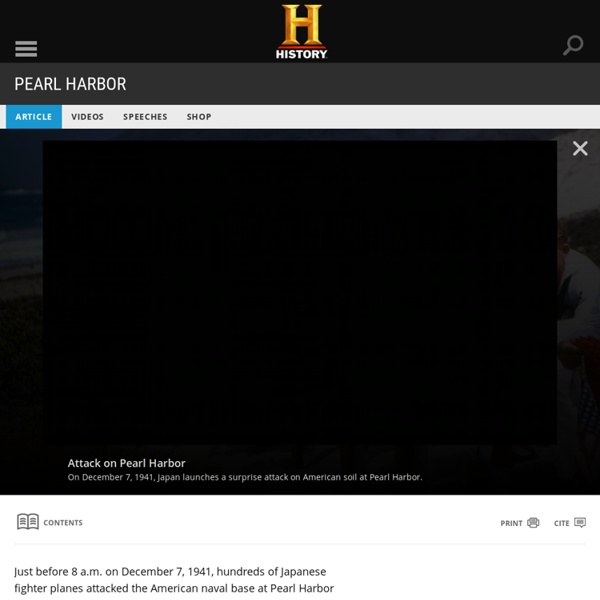



http://www.history.com/topics/world-war-ii/pearl-harbor
Related: TE 206 Week 7 AssignmentFemale WWII Pilots: The Original Fly Girls WASP (from left) Frances Green, Margaret Kirchner, Ann Waldner and Blanche Osborn leave their B-17, called Pistol Packin' Mama, during ferry training at Lockbourne Army Air Force base in Ohio. They're carrying their parachutes. National Archives hide caption toggle caption National Archives 5 Facts About Pearl Harbor and the USS Arizona At 7:55 a.m. Hawaii time (12:55 p.m. EST) on December 7, 1941, Japanese fighter planes attacked the U.S. base at Pearl Harbor, Hawaii, launching one of the deadliest attacks in American history.
Pearl Harbor in 1940-1941 By May 1940, when the main part of the United States Fleet was transferred there from the west coast, Pearl Harbor had long been under development as a major naval base. Its Navy Yard had a dry dock capable of holding the largest warships, a marine railway for smaller ones, and an industrial plant for repairing and maintaining these ships. There were abundant mooring and docking locations for ships, including a berthing area along the eastern side of Ford Island that was commonly called "Battleship Row". Ford Island, dominating the center of Pearl Harbor, held a Naval Air Station for combat landplanes and patrol seaplanes. Across Southeast Loch from the Navy Yard was a submarine base and nearby was a large "farm" of fuel oil tanks. The base also included a Naval Hospital and other facilities.
How Roosevelt Attacked Japan at Pearl Harbor Fall 1996, Vol. 28, No. 3 How Roosevelt Attacked Japan at Pearl Harbor Myth Masquerading as History By R.J.C. Butow © 1996 by R.J.C. Download 91,000 Historic Maps from the Massive David Rumsey Map Collection Three years ago, we highlighted one of the most comprehensive map collections in existence, the David Rumsey Map Collection, then newly moved to Stanford University. The Rumsey Collection, we wrote then, “contains a seemingly inexhaustible supply of cartographic images”—justifiable hyperbole, considering the amount of time it would take any one person to absorb the over 150,000 physical artifacts Rumsey has amassed in one place. By 2016, Rumsey had made almost half the collection—over 67,000 images—freely available in a digital archive that has been growing since 1996. Each entry features high-resolution scans for specialists (you can download them for free) and more manageable image sizes for enthusiasts; a wealth of data about provenance and historical context; and digital, user-friendly tools that use crowd-sourcing to measure the accuracy of antiquated maps against GPS renderings. To make this document even more compelling, it contains its own bibliography. Related Content:
Pearl Harbor Day: Key Facts About the Attack on December 7, 1941 (Dec. 7) -- It lives on in infamy. On Dec. 7 each year, Americans commemorate Pearl Harbor Day in memory of the thousands who were killed or injured when the Japanese attacked an American naval base in Hawaii that day in 1941. The attack is frequently cited as a major turning point in World War II. In his book "Smart Power," foreign policy expert Ted Galen Carpenter gives his take on the significance of the event. Carpenter writes: Pearl Harbor plunged America into the maelstrom of World War II, a struggle that involved the core security interests of the republic and symbolized rival visions for the future of the planet.
Pearl Harbor Images The 7 December 1941 Japanese raid on Pearl Harbor was one of the great defining moments in history. A single carefully-planned and well-executed stroke removed the United States Navy's battleship force as a possible threat to the Japanese Empire's southward expansion. America, unprepared and now considerably weakened, was abruptly brought into the Second World War as a full combatant. Eighteen months earlier, President Franklin D. Attack on Pearl Harbor 7 Dec 1941 Contributor: C. Peter Chen Here’s How America Uses Its Land Using surveys, satellite images and categorizations from various government agencies, the U.S. Department of Agriculture divides the U.S. into six major types of land. The data can’t be pinpointed to a city block—each square on the map represents 250,000 acres of land. But piecing the data together state-by-state can give a general sense of how U.S. land is used.
The Pearl Harbor Attack, 7 December 1941 Related Resources: The road to war between Japan and the United States began in the 1930s when differences over China drove the two nations apart. In 1931 Japan conquered Manchuria, which until then had been part of China. In 1937 Japan began a long and ultimately unsuccessful campaign to conquer the rest of China. Attack on Pearl Harbor The attack on Pearl Harbor[nb 4] was a surprise military strike conducted by the Imperial Japanese Navy against the United States naval base at Pearl Harbor, Hawaii, on the morning of December 7, 1941 (December 8 in Japan). The attack led to the United States' entry into World War II. The attack was intended as a preventive action in order to keep the U.S. Pacific Fleet from interfering with military actions the Empire of Japan was planning in Southeast Asia against overseas territories of the United Kingdom, the Netherlands, and the United States.
World War II (1939–1945): Japan and Pearl Harbor Events 1937 Japan goes to war with China July 1939 Roosevelt announces that Treaty of Commerce and Navigation will not be renewed July 2, 1940 U.S.